There’s a digital counterpart for nearly everything we do, which means more of our personal information is online. And although this tends to make our lives easier, it opens the door for information to land in the wrong hands. Identity theft happens when someone uses your personal identifiable information (PII) for their own monetary or personal gain. Sensitive data like credit card numbers and Social Security numbers can be incredibly valuable if it gets into the wrong hands.
The good news is that you can take steps to minimize the risk of identity theft. This article breaks down some of the most interesting fraud statistics and trends about identity theft in the United States and offers ways to protect your personal data from cybercriminals.
Identity theft by the numbers
The number of identity theft cases reported to the Federal Trade Commission (FTC) has increased in the last five years. According to the FTC’s Consumer Sentinel Network (CSN) report, the number of reported cases more than doubled from 2019 to 2020.
One possible reason for this upward trend is the coronavirus pandemic. Congress passed legislation that included more than $5 trillion in various government benefits. This money was helpful to out-of-luck Americans, but it was also extremely attractive to scammers who used the opportunity to create fake identities and steal unemployment checks. In fact, the most common type of identity theft this past year was government documents and benefits fraud.
What else do the numbers say about the rise in identity theft? Let’s take a closer look:
These statistics only scratch the surface, though. Keep reading to learn more about the latest identity theft data and what you can do to protect your personal information.
How common is identity theft in the U.S.?
Identity theft is a huge issue in the United States, and it doesn’t seem to be going away anytime soon. Fraud reports show that the number of identity thefts in the U.S. continues to grow and grow. The graph below shows the number of identity theft reports from the first quarter of 2017 to the first quarter of 2021.
The reported instances of identity theft have risen sharply from just over 100,000 in the first quarter of 2017 to well over 500,000 in the first quarter of 2021. 2020 had the sharpest increase in reports, as cybercriminals did their best to capitalize on the pandemic to take people’s government benefits.
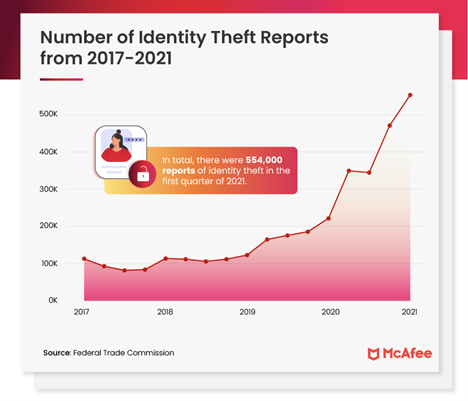
Identity theft, by state
Not every state is affected by ID theft equally. Where you live can have a big impact on your likelihood of experiencing identity theft. The graph below shows the amount of identity theft cases reported to the FTC per 100,000 residents for each state in the U.S.
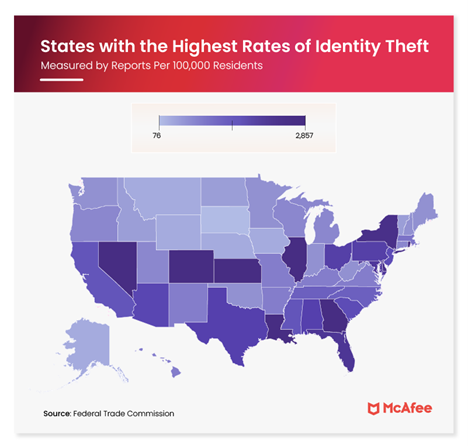
With a closer look, the five states with the most identity theft reports include Georgia, Louisiana, Illinois, Kansas, and Rhode Island, which takes the top spot. The number of reports in Rhode Island more than doubled in 2021, from 1,191 in 2020 to 2,857.
At the other end of the spectrum, South Dakota remained the state with the lowest occurrence of identity theft, with only 76 residents per 100,000 experiencing it.
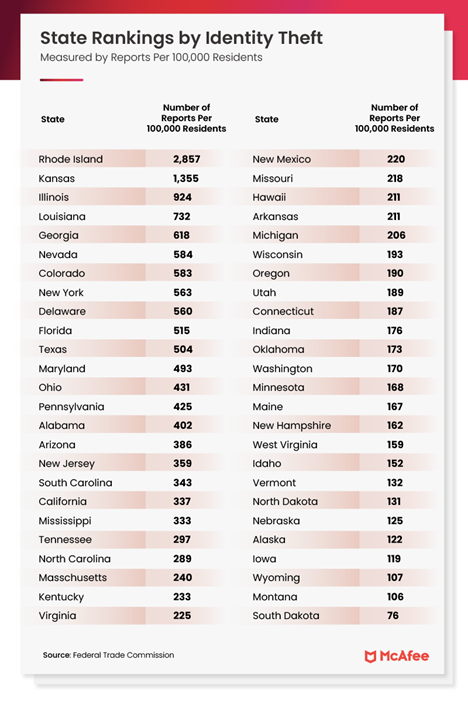
Here’s a list of the 20 metro cities where you have the highest chance of having your identity stolen.
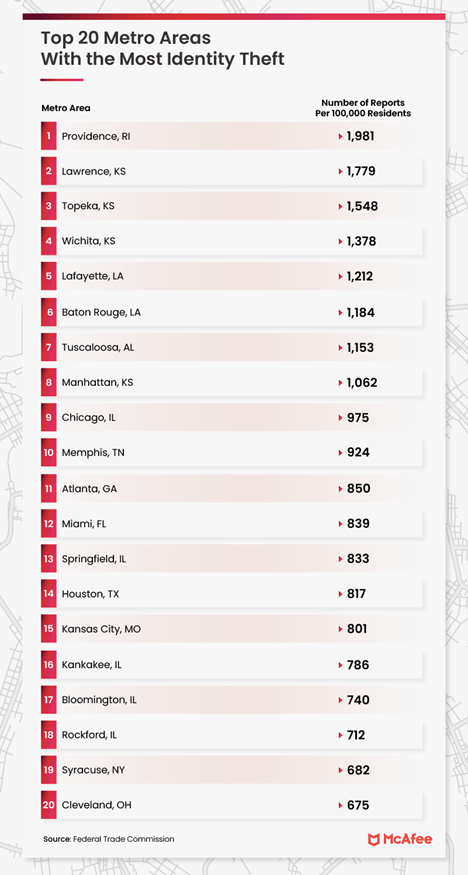
Who are the victims of identity theft?
Anyone can become the victim of identity theft, in large part because so much of our information is online. However, certain age groups are more likely to experience different types of scams.
For example, baby boomers are more likely than Generation Z to benefit from government programs. This makes them more susceptible to scams like benefits fraud (where a criminal poses as someone else to steal government benefits).
On the other hand, younger generations like millennials have grown up with the internet, and activities like shopping online are more frequent. This makes them more susceptible to identity theft through credit card fraud.
Here’s a breakdown of the most common identity theft types from various generations:
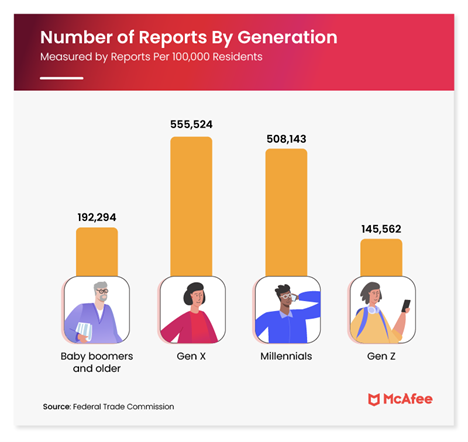
Types of identity theft
There are several different types of identity theft, ranging from stolen financial information to compromised health care data. Some forms are pretty straightforward. For instance, credit card fraud occurs when somebody steals your credit card number and uses it to buy things. Others, like medical identity theft, might be a bit harder to recognize.
Here’s a list of five of the most common types of identity theft:
- Financial identity theft: This form of identity theft is exactly what it sounds like and involves a criminal stealing your financial information. For instance, your credit card number can be stolen and used to make a purchase.
- Medical identity theft: With medical identity theft, someone steals your personal information to obtain health care services. An example is someone else using your identity to obtain prescription drugs.
- Criminal identity theft: This form of identity theft occurs when someone else uses your name when arrested. You’ll know this has happened to you if you receive a court summons, for instance, that you had no involvement with.
- Synthetic identity theft: A rising form of identity theft, synthetic identity theft is when someone creates a fake identity using someone’s real information. For instance, an imposter might create a fake identity using someone else’s real birthdate and Social Security number to apply for a loan.
- Child identity theft: With child identity theft, a criminal uses a minor’s personal information to commit bank fraud or another form of identity theft.
Although these are five of the most common types of identity theft, they can serve as umbrella terms for more specific forms of fraud. The diagram below shows the number of reported fraud cases of these various types of identity theft In 2021.
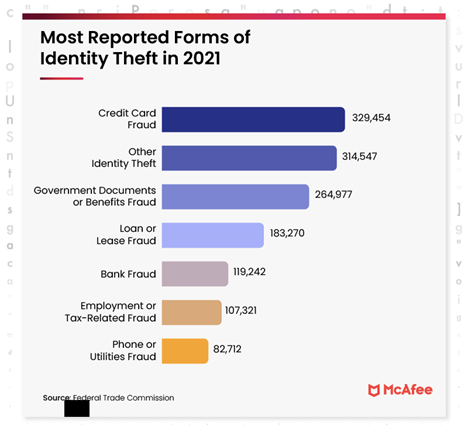
While the internet has made our day-to-day lives more convenient, it’s also made it much easier for scammers to steal our personal information. Identity theft has become increasingly more common in the United States over the past five years.
The more you use the internet, the more opportunities scammers have to steal your data and sell it on places like the dark web. Social media platforms, e-commerce businesses, banking companies, and a host of other online businesses can store your information for a variety of reasons.
If you use the internet for online shopping, for instance, there’s a good chance a large number of databases stored your personal and financial data. While businesses use your information to give you a better online experience, scammers can also access it to steal your identity.
The graph below shows the growth of different types of identity theft from 2017 to 2021.
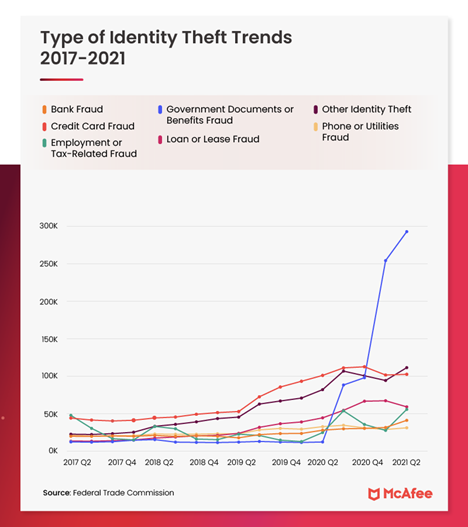
What should I do if I think I’m a victim of identity theft?
Criminals use many tricks to get your information. Scammers or hackers might send phishing emails pretending to be the IRS, snoop around social media pages for password clues, get info through a data breach, or simply buy information on the dark web.
Here are a few things you can do if you believe you are the victim of identity theft:
- Be on the lookout: To avoid identity theft, you’ll want to be alert for signs that someone has stolen your identity. Check your bank statement and credit report regularly to ensure no extra charges to your account. Pay attention to red flags like bills that arrive at your home with your information but someone else’s name, mysterious calls from debt collectors, or emails from new accounts for online services you don’t remember starting.
- Reach out to local law enforcement: Some banks may make you show them a police report before they reimburse you for any fraudulent charges or withdrawals.
- Contact the company where your ID is being used: Let the businesses where your information is being used know what’s happened. For instance, you’ll want to contact your bank and cancel your credit cards if you find out a criminal is using them.
- Get in touch with the three big credit bureaus: Call or message TransUnion, Equifax, and Experian right away. They may be able to diminish the impact an identity thief has on your credit score.
- File a report with the FTC: Reporting identity fraud to the FTC can help spread awareness of scams and identity theft tactics so others don’t fall victim to them.
- Visit the Identity Theft Resource Center: The ITRC has tools and information to help you protect yourself against identity theft and recover from it.
We’re here to help protect your personal information
The internet makes our lives easier in many ways. Although identity theft is rising, you shouldn’t let online scams prevent you from enjoying these digital conveniences. Identity thieves are an unavoidable part of using the internet, but you can greatly limit your risk of falling victim to cybercrime if you know what to watch out for and you’re smart online.
Recognizing the signs of identity theft can help you stay ahead of fraudsters, and investing in McAfee Identity Protection services can offer another layer of protection. When you sign up for our identity protection services, you get perks like $1 million in identity theft protection insurance and email address and bank account monitoring. With our help, you can continue to use the internet with confidence.
